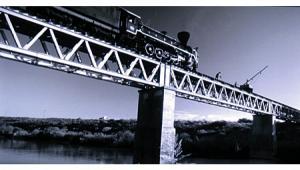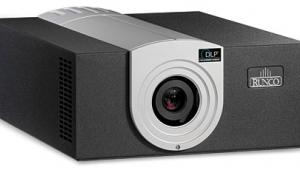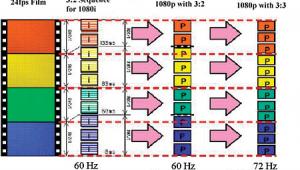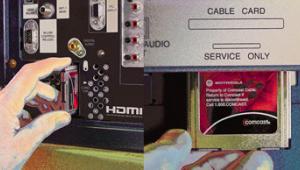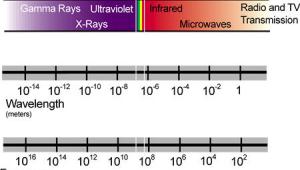Progressive-Scan or Progressive Scam? Page 3

The entry-level DV-434 lacks 3:2-pulldown detection, so we hesitate to call it a progressive-scan player.
Next, I looked at the various players' abilities to play back film-based DVDs using the Snell & Wilcox zone-test-plate pattern found on the Video Essentials DVD. This test pattern includes a bouncing ball of concentric circles in the middle of a stationary test pattern of resolution charts. This pattern represents moving images sourced from 24-frame film, 30-frame video, and 60-field video, sequentially. The DV-AX10 and Toshiba players were able to pick up on the 3:2-film-frame sequence and compensate for it accordingly. This means that they will play movies on DVD without the motion artifacts that can be caused by improperly handling the 3:2-frame sequence. The DV-AX10 was considerably faster at finding this sequence than the Toshiba player was. This is interesting, as some discs' frame sequences are not flagged correctly or sometimes break the 3:2 pattern. This will result in a brief glitch in the processing as the progressive players drop out of the film-processing mode and kick in to the video-processing mode.
As I expected, the DV-434 player didn't notice the film-frame sequence at all and processed the image as if it were regular video. Still, the DV-434 did a better job of processing the image than the Princeton's internal line doubler did. Diagonal lines on the opening of chapter 2 in the Bruce Willis apocalypse flick Armageddon were much smoother when they were processed by the DV-434 than by the Princeton's line doubler, but they were not quite as good as the output from the two progressive-scan players.

The back side of the DV-434 is pretty minimalist. You can't use the component and composite/S-video connections at the same time.
Not all DVDs originate from film, and some DVDs that are from film are not authored on the disc in such a way that a progressive player can recognize them as film. In these situations, the player may process the image as video. I noticed that both the DV-434 and the Toshiba SD-9200 did a better job of handling motion in video material than the DV-AX10 did, which poorly processed the test-pattern movement. I often use the Apollo 13 clip from the third DTS sampler DVD to test players because this clip was authored without the 3:2-sequence flags that are supposed to tell the player where the progressive images are. The fact that the Toshiba player did a reasonably good job with this clip indicates that the SD-9200 might recognize the film-frame sequence regardless of whether or not it's flagged on the disc. The DV-AX10, on the other hand, only seems to read the flags and, without them, processed the film in video mode.
 Equally important as the processing of video motion is the processing of the static portion of the video image. For example, when the Toshiba player switches from film mode into video mode, it loses some resolution in the process. If the film sequence is interrupted frequently, the player will switch in and out of these modes. While it's possible, it's not necessarily probable that a movie will do this—at least not for any significant length of time. The DV-434's resolution, on the other hand, was consistent, but only equal to the Toshiba's video mode. The DV-434 never switched in and out of this mode, though. The DV-AX10 did a much better job of preserving the resolution in static images, never really wavering between film and video sources.
Equally important as the processing of video motion is the processing of the static portion of the video image. For example, when the Toshiba player switches from film mode into video mode, it loses some resolution in the process. If the film sequence is interrupted frequently, the player will switch in and out of these modes. While it's possible, it's not necessarily probable that a movie will do this—at least not for any significant length of time. The DV-434's resolution, on the other hand, was consistent, but only equal to the Toshiba's video mode. The DV-434 never switched in and out of this mode, though. The DV-AX10 did a much better job of preserving the resolution in static images, never really wavering between film and video sources.
While this review wasn't meant to be a Face Off, it sort of ended up like one, which begs the question, who won? It's somewhat of a draw. Progressive-scan DVD players, like Toshiba's SD-9200 and Pioneer's DV-AX10, offer superior processing for the vast majority of DVD titles. They differed slightly in their processing of video material, and the DV-AX10 ultimately proves itself worthy of its higher price thanks to the addition of SACD capability. The DV-434, in my opinion, shouldn't be labeled as a progressive player. Perhaps it should be referred to as a DVD player with a progressive output—a subtle but important distinction. That said, the DV-434 is still a worthwhile player and an excellent value for those who are going to buy a DVD player anyway, want to get a better image than their TV's internal doubler can provide, and can't quite afford a full progressive player.
Highlights
Pioneer DV-434:
• Progressive output still better than the internal line doublers in most TVs
• Budget price

Highlights
Pioneer DV-AX10:
• Quick 3:2 recognition offers excellent progressive image
• Includes DVD-Audio and two-channel SACD




